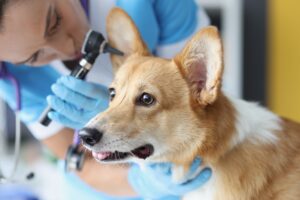Causes & Symptoms of Osteoarthritis in Dogs
 As a pet owner, your dog’s health and well-being are top priorities. One of the most common health issues faced by dogs is osteoarthritis, a degenerative joint disease that affects millions of dogs worldwide. At Affordable Pet Hospital in Tampa, we understand how important it is for pet owners to recognize the signs of this condition and take appropriate action to ensure their pets’ comfort and health. In this blog post, we will explore the causes and symptoms of osteoarthritis in dogs to help you better understand this common canine ailment.
As a pet owner, your dog’s health and well-being are top priorities. One of the most common health issues faced by dogs is osteoarthritis, a degenerative joint disease that affects millions of dogs worldwide. At Affordable Pet Hospital in Tampa, we understand how important it is for pet owners to recognize the signs of this condition and take appropriate action to ensure their pets’ comfort and health. In this blog post, we will explore the causes and symptoms of osteoarthritis in dogs to help you better understand this common canine ailment.
Causes of Osteoarthritis in Dogs
Osteoarthritis is a progressive, degenerative disease that affects the joints. The condition occurs when the cartilage that cushions the joints begins to break down, leading to inflammation and pain. There are several factors that can contribute to the development of osteoarthritis in dogs, including:
- Age
As dogs grow older, the cartilage in their joints becomes more susceptible to wear and tear. This natural aging process makes older dogs more prone to developing osteoarthritis.
- Genetics
Certain breeds, such as Labrador Retrievers, Golden Retrievers, and German Shepherds, have a higher predisposition to developing osteoarthritis due to their genetics.
- Weight
Excess weight puts additional strain on your dog’s joints, which can accelerate the breakdown of cartilage and lead to osteoarthritis.
- Trauma or Injury
Previous joint injuries, such as fractures or ligament tears, can increase the risk of developing osteoarthritis in the affected joint.
- Infections and Immune System Disorders
Some infections and immune system disorders, like Immune-Mediated Polyarthritis, can also contribute to the development of osteoarthritis in dogs.
Symptoms of Osteoarthritis in Dogs
Recognizing the symptoms of osteoarthritis in your dog is crucial for early intervention and proper treatment. Some common signs of osteoarthritis in dogs include:
- Limping or Lameness
One of the most noticeable signs of osteoarthritis is limping or favoring one leg over the other. This may be more evident after your dog has been resting or sleeping.
- Stiffness
Dogs with osteoarthritis may exhibit stiffness, particularly after periods of inactivity. You may notice that your dog has difficulty getting up from a lying position or seems reluctant to move around.
- Swollen Joints
Inflammation caused by osteoarthritis can lead to visibly swollen or enlarged joints.
- Decreased Activity
A dog suffering from osteoarthritis may become less active and show reduced interest in activities they once enjoyed, such as playing fetch or going for walks.
- Pain
Dogs with osteoarthritis may show signs of discomfort, such as whining or yelping when touched or when attempting to move.
- Behavioral Changes
Chronic pain can cause changes in your dog’s behavior, such as irritability, aggression, or depression.
If you notice any of these symptoms in your dog, it is essential to consult with a veterinarian, such as the caring professionals at Affordable Pet Hospital in Tampa. Early intervention can help slow down the progression of the disease and improve your dog’s quality of life.
Osteoarthritis Care for Your Dog in Tampa
Osteoarthritis is a common health issue faced by dogs, with various causes and symptoms. As a responsible pet owner, it is vital to be aware of the signs of osteoarthritis and seek prompt veterinary care if you suspect your dog may be suffering from this condition. At Affordable Pet Hospital, our team is ready to help you and your pup navigate treatment for osteoarthritis symptoms, so they can have the best quality of life possible. We offer wellness exams, critical care services, chiropractic treatments, and more. Call us at 813-991-9898 or schedule an appointment online at our Cross Creek Boulevard location today.

 Here at Affordable Pet Hospital in Tampa, we see many cases of dogs with
Here at Affordable Pet Hospital in Tampa, we see many cases of dogs with  You’ve probably heard about cataracts in humans, but did you know that your dog can get cataracts too? It’s true! This eye condition can affect dogs of all ages, sizes, and breeds. However, certain breeds are at a higher risk of developing cataracts. Additionally, other factors can also increase your dog’s risk of developing cataracts. In this post, we’ll break down how to spot canine cataracts and where to get the best treatment for your pup in Tampa Bay.
You’ve probably heard about cataracts in humans, but did you know that your dog can get cataracts too? It’s true! This eye condition can affect dogs of all ages, sizes, and breeds. However, certain breeds are at a higher risk of developing cataracts. Additionally, other factors can also increase your dog’s risk of developing cataracts. In this post, we’ll break down how to spot canine cataracts and where to get the best treatment for your pup in Tampa Bay. If your pup seems to always get
If your pup seems to always get  Just like humans,
Just like humans,  Dealing with a dog can be difficult for anyone, but raising a dog with a behavior problem is downright exhausting. Just like humans, dogs can have a variety of issues that cause inappropriate or undesired behaviors, such as fear, phobias, cognitive dysfunction, compulsive disorders, and frustration issues.
Dealing with a dog can be difficult for anyone, but raising a dog with a behavior problem is downright exhausting. Just like humans, dogs can have a variety of issues that cause inappropriate or undesired behaviors, such as fear, phobias, cognitive dysfunction, compulsive disorders, and frustration issues.



